STUDI A CURA DI ROBERTO CACCIALANZA
LEANDRO CROZAT - SISTEMA CROZAT
Leandro Crozat - Sistema Crozat
Biografia di Leandro Crozat e notizie sul brevetto d'invenzione
dei ritratti sul doppio fondo fotografico, colorito istantaneo
e vernice preservativa
(pubblicato il 24 febbraio 2015; seconda edizione ampliata, 15 luglio 2016)
IL "SISTEMA CROZAT" IN AUSTRIA
Questo articolo, pubblicato il 22 aprile 2017 e aggiornato in momenti successivi,
contiene informazioni non incluse nel libro
R. Caccialanza, Leandro Crozat - Sistema Crozat (2016)
Permanenza di Leandro Crozat in Austria e registrazione del privilegio del doppio fondo fotografico
(in base agli annunci pubblicati sui periodici locali)
Leandro Crozat arrivò a Vienna nella primavera del 1866 e prese residenza presso l'Hotel Wandl, in Petersplatz: gli arrivi di stranieri negli alberghi pubblicati sui periodici locali indicano la sua presenza dal giorno 20 aprile.
Il 28 giugno Crozat ottenne il privilegio per il doppio fondo fotografico, per la durata di un anno.
Ricercatori e appassionati di storia della fotografia che volessero condividere informazioni sulla diffusione del "Sistema Crozat" in Austria e/o fotografie prodotte con tale metodo, possono mettersi in contatto scrivendo a:
Neues Fremden-Blatt, 20 aprile 1866.

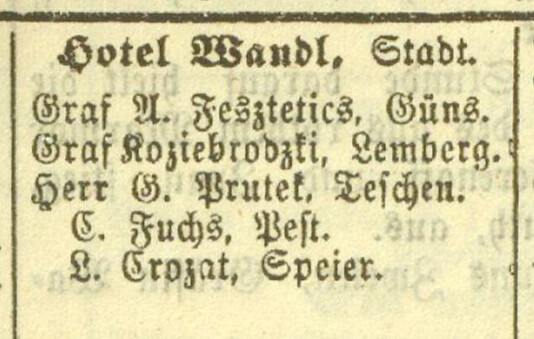
Fremden-Blatt, 21 aprile 1866.


Wiener Zeitung, 26 luglio 1866.



Ausschließende Privilegien.
Das Ministerium für Handel und Volkswirthschaft hat nachstehende Privilegien ertheilt.
Am 28 Juni 1866.
Dem Leander Cavaliere de Crozat, Photographen aus Alcoy in Spanien (Bevollmächtigter War Sonnenberg in Wien, Gumpendorferstraße Nr. 29), auf die Erfindung, bei photographischen Bildern einen doppelten photographischen Grund zu erzeugen, für die Dauer Eines Jahres.
Privilegi esclusivi.
Il Ministero del Commercio e l'economia nazionale ha concesso i seguenti privilegi.
Il 28 giugno 1866.
Cavaliere Leandro Crozat, fotografo di Alcoy in Spagna (agente Sonnenberg a Vienna, Gumpendorferstraße n. 29), per l'invenzione di produrre un doppio fondo fotografico, per la durata di un anno.
Klagenfurter Zeitung, 2 agosto 1866.

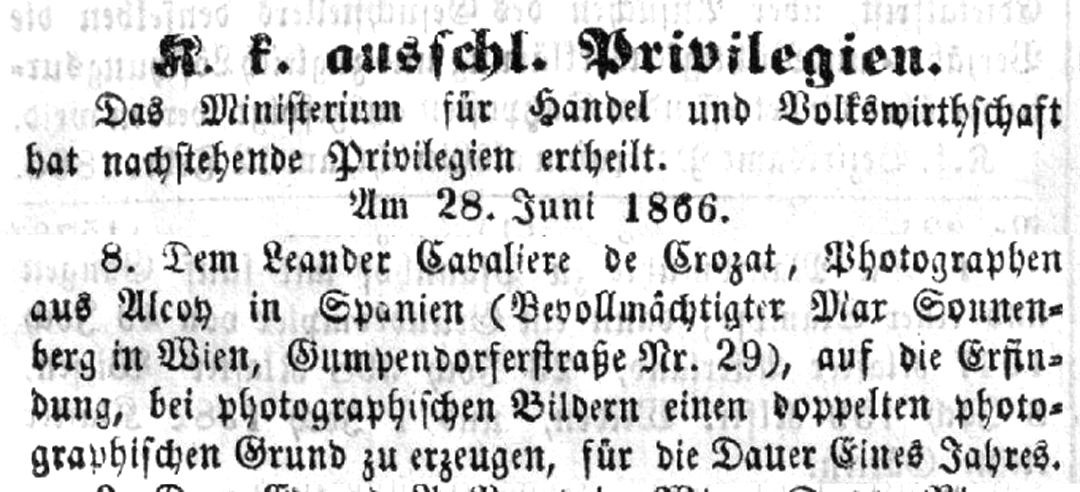
Documenti per la registrazione del brevetto in Austria
(per gentile concessione di: Austrian Patent Office - Österreichisches Patentamt)



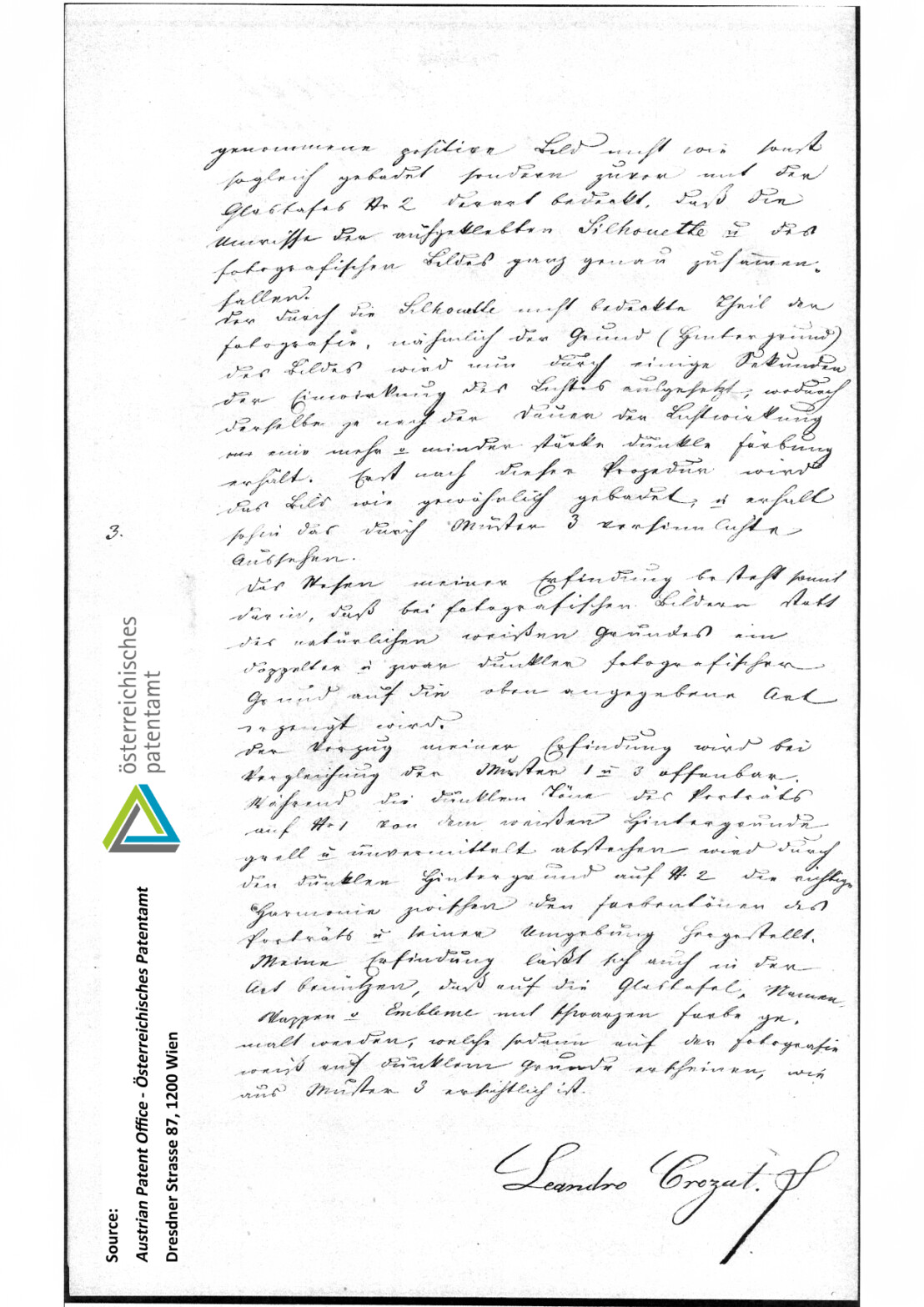

I disegni sono allegati alla richiesta di privilegio. L'Austrian Patent Office afferma che non si tratta di cartes de visite fotografiche originali.
IL "SISTEMA CROZAT" IN FRANCIA
Questo articolo, pubblicato il 1* aprile 2017, contiene informazioni non incluse nel libro
R. Caccialanza, Leandro Crozat - Sistema Crozat (2016)
Permanenza di Leandro Crozat in Francia: la "Photographie Artistique D. Burguet & Cie."
Dopo la scoperta, da parte del sottoscritto, della Mémoire (memoriale) pubblicata da Leandro Crozat a Marsiglia nel 1864 con la collaborazione del fotografo Jean Vanel (si veda a p. 33 del libro Leandro Crozat - Sistema Crozat), è iniziata la ricerca di ritratti in carte de visite con iscrizioni relative al "Sistema Crozat".
Finalmente, dopo anni, la tenacia è stata premiata. Ecco quindi una carte de visite prodotta dalla "Photographie Artistique - D. Burguet & Cie - Peintres et photographes" di Parigi: sul retro si trovano gli stemmi caratteristici, inconfondibili, che testimoniano la correlazione con il "Sistema Crozat": quelli del Regno Unito, dell'Italia e della Spagna, dove Crozat aveva avviato o completato le pratiche per ottenere il brevetto (o privativa, che dir si voglia); in cima a tutti, ovviamente, quello della Francia (non poteva mancare...).
Poche sono le informazioni su Burguet o Du Burguet: all'atto di matrimonio del 1867 con M.lle Theuriot (9° arrondissement di Parigi) era residente in rue Fontaine 12. C'è, poi, l'articolo che si riporta di seguito, pubblicato in Musée des familles nel 1875, dove si parla di Burguet, fotografo, e di Leymarie, libraio, condannati e imprigionati per una vicenda di frode per "fotografie spiritiche" (Leandro Crozat fu fondatore e membro di società spiritiste in Argentina, si veda a p. 73 del libro Leandro Crozat - Sistema Crozat).
Si aggiunge, dunque, un nuovo e importante tassello nella storia della diffusione del "Sistema Crozat" in Europa.
Ricercatori e appassionati di storia della fotografia che volessero condividere informazioni sulla diffusione del "Sistema Crozat" in Francia e/o fotografie prodotte con tale metodo, possono mettersi in contatto scrivendo a:

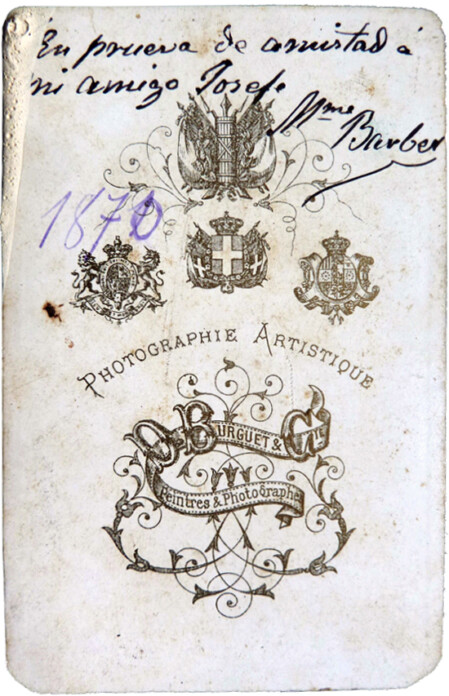
"Photographie Artistique - D. Burguet & Cie. - Peintres et photographes" (Parigi)
Collezione F. e R. Caccialanza


"Photographie Artistique - D. Burguet & Cie. - Peintres et photographes" (Parigi)
Collezione Djedj Lantz
Grazie al Journal des débats politiques et littéraires del 19 giugno 1875 possiamo sapere che Édouard Isidore Burguet (o Buguet) era un "ragazzone" trentaseienne con modi insolenti e sgraziati, ed aveva il proprio atelier di fotografia a Parigi in boulevard Montmartre 5. Nel lungo articolo si riportano le testimonianze riferite durante il processo e si afferma che la Revue spirite (giornale di studi psicologici) fondata a Parigi da Allan Kardec e proseguita dopo la morte di questi a nome di una Società Anonima da Leymarie, aveva fatto spesso riferimento a fotografie spiritiche provenienti dall'America. Alla fine del 1873 la rivista spiritista aveva annunciato che un "fotografo di nome Buguet, stabilito a Parigi in boulevard Montmartre 5", era dotato di facoltà di medium e che era giunto, grazie all'intervento soprannaturale degli spiriti, a risultati fotografici simili a quelli d'oltreoceano (Stati Uniti, per intercessione del medium americano Henri-Alfred Firmann).
Buguet richiedeva 20 Franchi per sei copie di una fotografia spiritica in formato carte de visite, ma non dava assicurazioni al cliente che il fantasma ritratto in fotografia avesse esattamente le sembianze del proprio caro (...).
Nella Gazette des tribunaux si legge che, per la truffa delle "fotografie spiritiche", Burguet (Buguet) e Pierre-Gaëtan Leymarie furono condannati a un anno di prigione e 300 Franchi di multa.
Anche la rivista Musée des familles - Lectures du soir offre interessanti informazioni.
Musée des familles - Lectures du soir, vol. 42, 1875, pp. 255-256.

IL "SISTEMA CROZAT" IN IRLANDA
Questo articolo, pubblicato il 19 dicembre 2016, contiene informazioni non incluse nel libro
R. Caccialanza, Leandro Crozat - Sistema Crozat (2016)
Fotografi irlandesi che certamente acquisirono il "Sistema Crozat"
(in base agli annunci pubblicati sui periodici locali)
SIMONTON, James
(Dublino, 69 e 70, Grafton-street, all'angolo di Harry-street)
ROBINSON, James
(Dublino, 65, Grafton-street)
GEARY brothers - PHOTOGRAPHIC INSTITUTE
(Kilkenny, Patrick-street)
Ricercatori e appassionati di storia della fotografia che volessero condividere informazioni sulla diffusione del "Sistema Crozat" in Irlanda e/o fotografie prodotte con tale metodo, possono mettersi in contatto scrivendo a:
The Freeman's Journal, 7 novembre 1864.
BY ROYAL LETTERS PATENT.
STARTLING NOVELTY IN PHOTOGRAPHY!
NEW DOUBLE TINT ENAMELLED VIGNETTES
(Crozat’s System).
“PALMAN QUI MERUIT FERAT.”
ROYAL PANOPTICON OF SCIENCE AND ART,
69 AND 70, GRAFTON-STREET, NOV. 7, 1864
JAMES SIMONTON, Opcitian and Photographer, begs respectfully to inform his Patrons and the Public htat, taking advantage of the recent discoveries in Photography on the Continent, he is enabled to offer a great improvement on the ordinary Carte-de-Visite Portraits by the
NEW DOUBLE TINT ENAMELLED VINGNETTES.
Which for richness of effect, depth of tone, softness in light and shade, singular beauty, and startling effect, must eclipse any of the former known styles of Photography extant.
This new and truly beautiful process increases the richness of the Photograph, preserves the hitherto evanescent image from atmospheric action, and produces a marvelous amount of delicacy and a brilliancy of effect hitherto unequalled by any known process of Portraiture. The surface is not affected by contact, and is perfectly impervious to moisture, change of climate, or chemical influences.
The above new process combines –
First – Complete stability and brilliancy of colour, for if they are immersed under water for twelve months they will not fade or be impaired in delicate detail or permanency.
Second – The life-like reality, transparency, richness of beauty, and life-like colouring have never before been accomplished by any known process of Photography.
Third – The value given to the flesh tints and tout ensemble by the bi-chromatic or double-tint printing leaves nothing further to be desired, producing a most marvellous result, the surface belong enameled equal to the finest polished glass, while the effect of tone produced by the colouring, gives a startling reality which must only be seen to be appreciated.
To carry out the details of the Patent to the fullest extent, J. S. has erected, at considerable expense, spacious Operating Rooms, extending from 69 and 70, Grafton-street, to 1 and 2, Harry-street, and he can confidently rely on the continuance of that support so liberally bestowed on him since his commencement in business.
JAMES SIMONTON,
Optician and Photographer to the Queen,
ROYAL PANOPTICON of SCIENCE and ART,
69 and 70, GRAFTON-STREET
(Corner of Harry-street).
J. S. Intimates that he is instructed by the Patentee to issue legal proceedings against any one attempting to infringe the above named process.
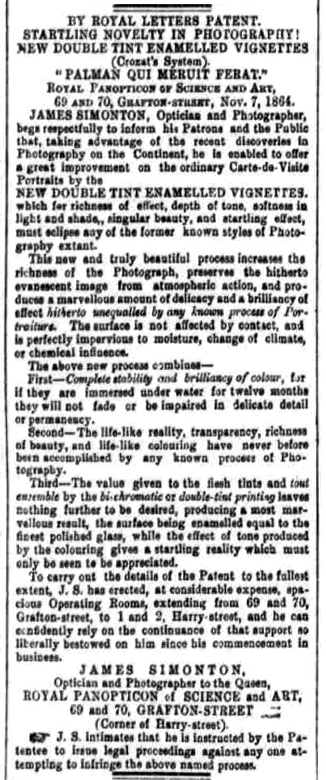
Saunder's News-letter, 12 novembre 1864.

NOVEL DISCOVERY IN PHOTOGRAPHY.
Amongst the most beautifully attractive and striking discoveries in photography are the new “double-tint enameled vignettes”, now on view at the gallery of Simonton, of the Royal Panopticon, 69 and 70, Grafton-Street. One of the great wants under which photography has labored up to the present was that photographs were not enduring. This process, which has been subjected to the most severe tests, and now introduced here from Seville for the first time, through the enterprise of Mr. Simonton, makes the photograph not only enduring but imparts to it a beauty, softness, and elegance of finish hitherto unknown. “the process is named The new double tint enameled vignettes”, and has been patented for this country by Mr. Simonton. We have just been favoured with an opportunity of inspecting these exquisite works of art, and we have no hesitation in stating that all that has been said in praise falls short of conveying a proper notion of their great excellence. Indeed they took us quite by surprise, and we have not heard any opinion expressed by those who have seen them but of warm and unreserved praise. For the purpose of carrying out the patent Mr. Simonton has erected large operating rooms, extending from his premises in Grafton-street into Harry-street. The cartes de visite shown by Mr. Simonton possess all the merit to be recognized in the most elegantly finished miniatures of giving full protection to the portraits, and, while it secures them from the influence of friction, climate, or the wear and tear of time, it makes them appear to the very best advantage. Those who will visit the gallery of Mr. Simonton can judge for themselves of the high merit and rare excellence of a process in photographic art as ingenious as it is valuable.
Saunder's News-letter, 30 novembre 1864.
NOVELTIES IN PHOTOGRAPHY.
JAMES ROBINSON
Invites Public attention to his Magnificient specimens of
ENAMELLED VIGNETTE PHOTOGRAPHS,
Which exceed anything yet produced in Dublin in brilliancy
and beauty. Also the new
DIAMOND PHOTOGRAPHS,
Which exhibit the Face in four different positions.
J. R. begs also to announce that he has just made a discovery which will ensure the greatest permanence in all Photographs produced at his Establishment.
POLYTECHNIC MUSEUM and PHOTOGRAPHIC GALLERIES,
65 GRAFTON-STREET.

Kilkenny Journal, and Leinster Commercial and Literary Advertiser, 1* aprile 1865.
PHOTOGRAPHIC NOVELTIES
Crozat’s System of Double Ground
Tinted and Enamelled Vignettes,
Patented.
The above New and Very Beautiful Style will, it is expected, completely supersede the present “Carte de Visite”, the advantages presented being the beauty and delicacy of finish, combined with a greater degree of permanency, which adds a charm to this class of Photograph hitherto unequalled in any other style, not the least important is the perfect protection from deleterious atmospheric influence, water having no power to penetrate the protected or enameled surface. The tinting of these pictures renders them startlingly life-like, and the enamelled surface gives a softness and beauty more like the delicate tone of a painting on ivory than any ordinary paper print could produce.
Messrs GEARY BROTHERS, having purchased the patent right from Signor Crozat (Spain), are now ready to execute orders in the above style, and trust they may be favoured with as great a share of success in this new process as they have hitherto received in all other styles of Photography.
Messrs G. also beg to call attention to their New Photographic Doubles, or Eccentric and Amusing Conversation Carte de Visite, in which two views of the one individual are seen in different attitudes on the same “Carte”, such as a man sitting in a room talking to himself, (his duplicate), a girl pushing a perambulator with herself seated in it, &c., &c., in fact any pose suggested can be accomplished in this new style of Carte de Visite.
Messrs GEARY beg to intimate that in consequence of the introduction of superior novelties, they have reduced the price of their ordinary Cartes de Visite to 2s 6d for the First Copy.
PHOTOGRAPHIC INSTITUTE,
PATRICK-STREET, KILKENNY.

Saunder's News-letter, 1* giugno 1871.
NEW STYLE OF
PHOTOGRAPHIC PORTRAITURE.
JAMES SIMONTON
Announces a New and Suerior Embossed and Enamelled Photographic Portrait, impervious to damp (Crozat’s system), which has only to be seen to merit a large share of Public Patronage.
JAMES SIMONTON.
OPTICIAN TO THE LORD LIEUTENANT,
Royal Panopticon of Science and Art,
70 GRAFTON-STREET.
Specimens to be seen daily.
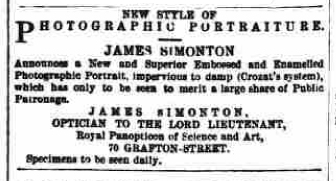
IL "SISTEMA CROZAT" IN SVIZZERA
Questo articolo, pubblicato il 3 luglio 2021, contiene informazioni non incluse nel libro
R. Caccialanza, Leandro Crozat - Sistema Crozat (2016)
Fotografi svizzeri che utilizzarono il "Sistema Crozat"
(in base agli annunci pubblicati sui periodici locali)
Stabilimento fotografico "GALLERIA SUD-AMERICANA" di Brunel / BRUNEL, Grato
(Lugano, Bellinzona, Airolo)
FANCONI, Guglielmo
(Poschiavo)
VASSENA, Noè
(Bellinzona)
Ricercatori e appassionati di storia della fotografia che volessero condividere informazioni sulla diffusione del "Sistema Crozat" in Svizzera e/o fotografie prodotte con tale metodo, possono mettersi in contatto scrivendo a:
Gazzetta Ticinese, 12, 26 giugno, 7, 10, 15, 18, 22, 25, 31 luglio 1871.

GALLERIA SUD-AMERICANA
FOTOGRAFIA BRUNEL in LUGANO.
Ritratti lucidi, doppio fondo: sistema CROZAT
eseguiti con tutta esattezza.
Gazzetta Ticinese, 10, 13, 17, 20, 30 ottobre 1876.
AVVISO.
La ben nota Fotografia L. [Ludovico] Brunel, stabilita in Bellinzona, fa conoscere ai signori Committenti che nella prossima stagione jemale aprirà un altro Stabilimento ad Airolo nel rinomato Albergo Motta. I lavori verranno eseguiti in galleria chiusa e coperta con vetri, e colle perfezionatissime macchine Voigtländer e Dall-Meyer, senza temere concorrenza alcuna, ed a prezzi modicissimi. Ritratti dalla più piccola dimensione alla grandezza naturale, gruppi, glacés, sistema Crozat. Ricca collezione di vedute di tutto il Cantone, non che quella d'Airolo e suoi dintorni e dell'Impresa Favre. S'incarica anche d'inquadramenti, cornice, passepartouts ecc.
Avendo licenziato già dal 28 agosto p.° p.° il lavorante Gio. Pedretti, il sottoscritto eseguisce egli stesso ogni lavoro fotografico, onde meglio soddisfare la sua numerosa clientela. Si reca a domicilio.
L. Brunel, fotografo.

Il Grigione Italiano, 16 maggio 1885.

FOTOGRAFIA.
Reduce dall'Italia mi pregio render di notorietà a questo colto pubblico d'aver impiantato quì a Poschiavo, in casa Jochum, uno stabilimento fotografico. Nel tempo stesso che a numerosa clientela mi lusingo, faccio osservare che provvisto fra altro di una eccellente e privilegiata macchina di Germania, sono in grado di soddisfare il pubblico in qualunque ora del giorno anche col cattivo tempo in qualsiasi genere di ritratti in ogni formato, riproduzioni, gruppi, vedute, ecc. tanto lisci, come a doppio fondo ed a vernice sistema Crozat.
Tengo già pronte in vendita copie del Ritorno da Selva sulla piazza comunale.
Guglielmo Fanconi, fotografo.
Si segnala, infine, la presenza nel Cantone Ticino, a Bellinzona, del fotografo professionista lecchese Noè Vassena,
già attivo in numerose località lombarde, che possedeva il diritto di privativa del "Sistema Crozat".
INDICE
Presentazione
Leandro e Nicolás, i fratelli Crozat di Sempére: notizie biografiche
I Privilegi di fotografia registrati in Spagna prima del 1862
21 novembre 1862: il privilegio del ‘doppio fondo fotografico’
Il ‘doppio fondo’, il ‘colorito instantaneo’ e i procedimenti similari
Diffusione del Privilegio in Spagna
Il ‘sistema Crozat’ in Francia
Il ‘sistema Crozat’ nel Regno Unito
Leandro Crozat in Italia
Gli scudi che contraddistinguono le cartes de visite realizzate in Italia con il ‘sistema Crozat’
Il rientro in Spagna: la direzione della raffineria di zucchero di Badalona
LEANDRO CROZAT IN SUDAMERICA
Uruguay (Montevideo)
Brasile
Argentina: la rivendicazione dei diritti del ‘sistema Crozat’; La colonizzazione delle terre in Patagonia; Leandro Crozat fondatore e membro di Società spiritiste; Il ‘Centro Industrial Argentino’
Cile
Perù
Portogallo
Il ‘sistema Crozat’ ad Alessandria d’Egitto: Luigi Fiorillo
APPENDICE
Madrid, 21 novembre 1862: Real Cédula de privilegio de invención
(versione integrale in lingua originale)
Marseille, 1864: Mémoire sur la photographie à deux teintes ou à double fond, et le coloris instantané d'après le système de Crozat
(versione integrale in lingua originale)
United Kingdom, november 23, 1864: Patents for inventions. Abridgments of specifications relating to Photography
(versione integrale in lingua originale)
United Kingdom, november 25, 1864: Provisional specification left by Leandro Crozat at the Office of the Commissioners of Patents
(versione integrale in lingua originale)
Torino, 14 febbraio 1865: Descrizione del ritrovato che ha per titolo ‘doppio fondo fotografico’, innovazione al ritratto detto ‘Fond-perdu’
(versione integrale)
Torino, 23 febbraio 1865: Testo della privativa pubblicata sul Bollettino industriale del Regno d’Italia
(versione integrale)
Torino, 13 marzo 1865: Memoria sul doppio fondo fotografico, sul colorito istantaneo e sulla vernice preservativa ‘sistema Crozat’
(versione integrale)
Torino, 23 maggio 1865: Ministero di Agricoltura, Industria e Commercio, Bollettino industriale del Regno d’Italia, Torino 1865
(versione integrale)
La cessione del ‘sistema Crozat’ ai fotografi italiani (avvisi tratti dalla ’Gazzetta Ufficiale del Regno d’Italia’)
Elenco di fotografi italiani che hanno utilizzato il ‘sistema Crozat’
La cessione della Privativa a Felice Tarantola (Novara) e a Enrico Van Lint (Pisa)
Note
Ringraziamenti
COME ACQUISTARE IL LIBRO
124 pagine a colori (115 illustrazioni), dimensioni 29,7x21 cm.
copertina morbida 300 gr. plastificata opaca, pagine carta patinata opaca 135 gr.
ilmiolibro, 24 febbraio 2015 (prima edizione)
ilmiolibro, 15 luglio 2016 (seconda edizione)
ISBN: 9788892316829
Acquista il libro (ilmiolibro.it)


